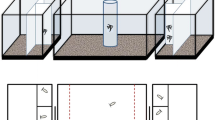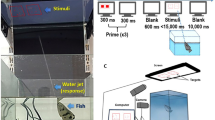Abstract
Number sense is a key cognitive function in animals. The biological functions of number discrimination have a wide range, including the selection of prey and social interaction. In a previous study, we have shown that cuttlefish are able to distinguish numerical differences among various integers, including 1 vs. 2, 2 vs. 3, 3 vs. 4, and 4 vs. 5. However, it is not known whether cuttlefish are able to discriminate various fractions, that is, various non-integer numbers. In addition, no study on invertebrates has examined fraction number sense. Using the active preying behavior of cuttlefish (Sepia pharaonis), we investigated the spontaneous preference for larger quantity by presenting two-alternative choice between 1 vs. 1.5, 1.5 vs. 2, 2 vs. 2.5, and 2.5 vs. 3. In this context, the quantity1.5 is composed of one large shrimp and one small shrimp, in which the size of the small shrimp is one-half of that of the large shrimp. The result shows that the cuttlefish chose larger quantity in the first three pairs, but they could not distinguish the pair 2.5 vs. 3. Despite that the absolute differences in these pairs are the same (0.5), the relative differences in these pairs decrease (0.5, 0.33, 0.25, and 0.2, respectively). This implies that the perceived difference in quantity is proportional to the initial quantity (Weber’s law). Although the present study does not truly differentiate the number difference from the quantity difference, this result does raise the possibility that cuttlefish may be equipped with the primitive concept of fractions, and if so, the perceived just noticeable difference is similar for both integer and fraction number discrimination.


Similar content being viewed by others
References
Agin W, Chichery R, Dickel L, Chichery MP (2006) The “prawn-in-the-tube” procedure in the cuttlefish: habituation or passive avoidance learning? Learn Mem 13(1):97–101
Agrillo C, Bisazza A (2014) Spontaneous versus trained numerical abilities: a comparison between the two main tools to study numerical competence in non-human animals. J Neurosci Methods 234:82–91
Agrillo C, Piffer L, Bisazza A, Butterworth B (2012) Evidence for two numerical systems that are similar in humans and guppies. PLoS One 7(2):e31923. https://doi.org/10.1371/journal.pone.0031923
Agrillo C, Petrazzini MEM, Bisazza A (2017) Numerical abilities in fish: a methodological review. Behav Process 141:161–171
Bar-Shai N, Keasar T, Shmida A (2011) The use of numerical information by bees in foraging tasks. Behav Ecol 22(2):317–325
Bisazza A, Agrillo C, Lucon-Xiccato T (2014) Extensive training extends numerical abilities of guppies. Anim Cogn 17(6):1413–1419
Brannon EM, Terrace HS (1998) Ordering of the numerosities 1 to 9 by monkeys. Science 282(5389):746–749
Darmaillacq AS, Dickel L, Mather J (2014) Cephalopod cognition. Cambridge University Press, Cambridge
Fechner GT (1860) Elemente der Psychophysik. Leipzig: Breitkopf und Härtel
Feigenson L, Dehaene S, Spelke E (2004) Core systems of number. Trends Cogn Sci 8(7):307–314
Gomez-Laplaza LM, Gerlai R (2013a) Quantification abilities in angelfish (Pterophyllum scalare): the influence of continuous variables. Anim Cogn 16(3):373–383
Gomez-Laplaza LM, Gerlai R (2013b) The role of body surface area in quantity discrimination in angelfish (Pterophyllum scalare). PLoS One 8(12):e83880. https://doi.org/10.1371/journal.pone.0083880
Hanlon RT, Messenger JB (2018) Cephalopod behaviour. Cambridge University Press, Cambridge
Hanus D, Call J (2007) Discrete quantity judgments in the great apes (Pan paniscus, Pan troglodytes, Gorilla gorilla, Pongo pygmaeus): the effect of presenting whole sets versus item-by-item. J Comp Psychol 121(3):241–249
Harper DGC (1982) Competitive foraging in mallards—ideal free ducks. Anim Behav 30(May):575–584
Jones SM, Pearson J, DeWind NK, Paulsen D, Tenekedjieva AM, Brannon EM (2014) Lemurs and macaques show similar numerical sensitivity. Anim Cogn 17(3):503–515
Jordan KE, Brannon EM (2006) The multisensory representation of number in infancy. Proc Natl Acad Sci USA 103(9):3486–3489
Jozet-Alves C, Viblanc VA, Romagny S, Dacher M, Healy SD, Dickel L (2012) Visual lateralization is task and age dependent in cuttlefish, Sepia officinalis. Anim Behav 83(6):1313–1318
Lin IR, Chiao CC (2017) Visual equivalence and amodal completion in cuttlefish. Front Physiol 8:40. https://doi.org/10.3389/fphys.2017.00040
McCrink K, Wynn K (2007) Ratio abstraction by 6-month-old infants. Psychol Sci 18(8):740–745
Messenger JB (1968) Visual attack of cuttlefish Sepia officinalis. Anim Behav 16(2):342–357
Messenger JB (1971) 2-stage recovery of a response in Sepia. Nature 232(5307):202–203
Messenger JB (1973) Learning in the cuttlefish Sepia. Anim Behav 21:801–826
Nelson XJ, Jackson RR (2012) The role of numerical competence in a specialized predatory strategy of an araneophagic spider. Anim Cogn 15(4):699–710
Nieder A (2016) The neuronal code for number. Nat Rev Neurosci 17(6):366–382
Nieder A (2017) Evolution of cognitive and neural solutions enabling numerosity judgements: lessons from primates and corvids. Philos Trans R Soc B 373(1740):20160514. https://doi.org/10.1098/rstb.2016.0514
Pahl M, Si A, Zhang SW (2013) Numerical cognition in bees and other insects. Front Psychol 4:162
Panteleeva S, Reznikova Z, Vygonyailova O (2013) Quantity judgments in the context of risk/reward decision making in striped field mice: first “count,” then hunt. Front Psychol 4:53
Piazza M, Izard V (2009) How humans count: numerosity and the parietal cortex. Neuroscientist 15(3):261–273
Rugani R, Vallortigara G, Regolin L (2015) The use of proportion by young domestic chicks (Gallus gallus). Anim Cogn 18(3):605–616
Rugani R, McCrink K, de Hevia MD, Vallortigara G, Regolin L (2016) Ratio abstraction over discrete magnitudes by newly hatched domestic chicks (Gallus gallus). Sci Rep UK 6:30114. https://doi.org/10.1038/srep30114
Stancher G, Rugani R, Regolin L, Vallortigara G (2015) Numerical discrimination by frogs (Bombina orientalis). Anim Cogn 18(1):219–229
Uller C, Lewis J (2009) Horses (Equus caballus) select the greater of two quantities in small numerical contrasts. Anim Cogn 12(5):733–738
Vallentin D, Nieder A (2008) Behavioral and prefrontal representation of spatial proportions in the monkey. Curr Biol 18(18):1420–1425
Vallentin D, Nieder A (2010) Representations of visual proportions in the primate posterior parietal and prefrontal cortices. Eur J Neurosci 32(8):1380–1387
Woodruff G, Premack D (1981) Primitive mathematical concepts in the chimpanzee—proportionality and numerosity. Nature 293(5833):568–570
Yang TI, Chiao CC (2016) Number sense and state-dependent valuation in cuttlefish. Proc R Soc B Biol Sci 283(1837):20161379. https://doi.org/10.1098/rspb.2016.1379
Acknowledgements
We are grateful to Ms. Tzu-Hsin Kuo for helping with the experiments and discussing the results with us. We thank Dr. Te-Hua Hsu and Mr. Yao-Chen Lee for collecting the cuttlefish eggs from Keelung and Gongliao. We also appreciate Ms. Ting-Chia Hsu at the National Hsinchu Girls’ Senior High School for encouraging YHH, HJL, and LYL to pursue this project.
Funding
This study was funded by the Ministry of Science and Technology of Taiwan (Grant number MOST-106-2311-B-007-010-MY3).
Author information
Authors and Affiliations
Corresponding author
Ethics declarations
Ethical approval
All applicable international, national, and/or institutional guidelines for the care and use of animals were followed. This article does not contain any studies with human participants performed by any of the authors.
Conflict of interest
All authors (YH Huang, HJ Lin, LY Lin, and CC Chiao) declare that they have no conflict of interest.
Additional information
Publisher’s Note
Springer Nature remains neutral with regard to jurisdictional claims in published maps and institutional affiliations.
Rights and permissions
About this article
Cite this article
Huang, YH., Lin, HJ., Lin, LY. et al. Do cuttlefish have fraction number sense?. Anim Cogn 22, 163–168 (2019). https://doi.org/10.1007/s10071-018-01232-3
Received:
Revised:
Accepted:
Published:
Issue Date:
DOI: https://doi.org/10.1007/s10071-018-01232-3




